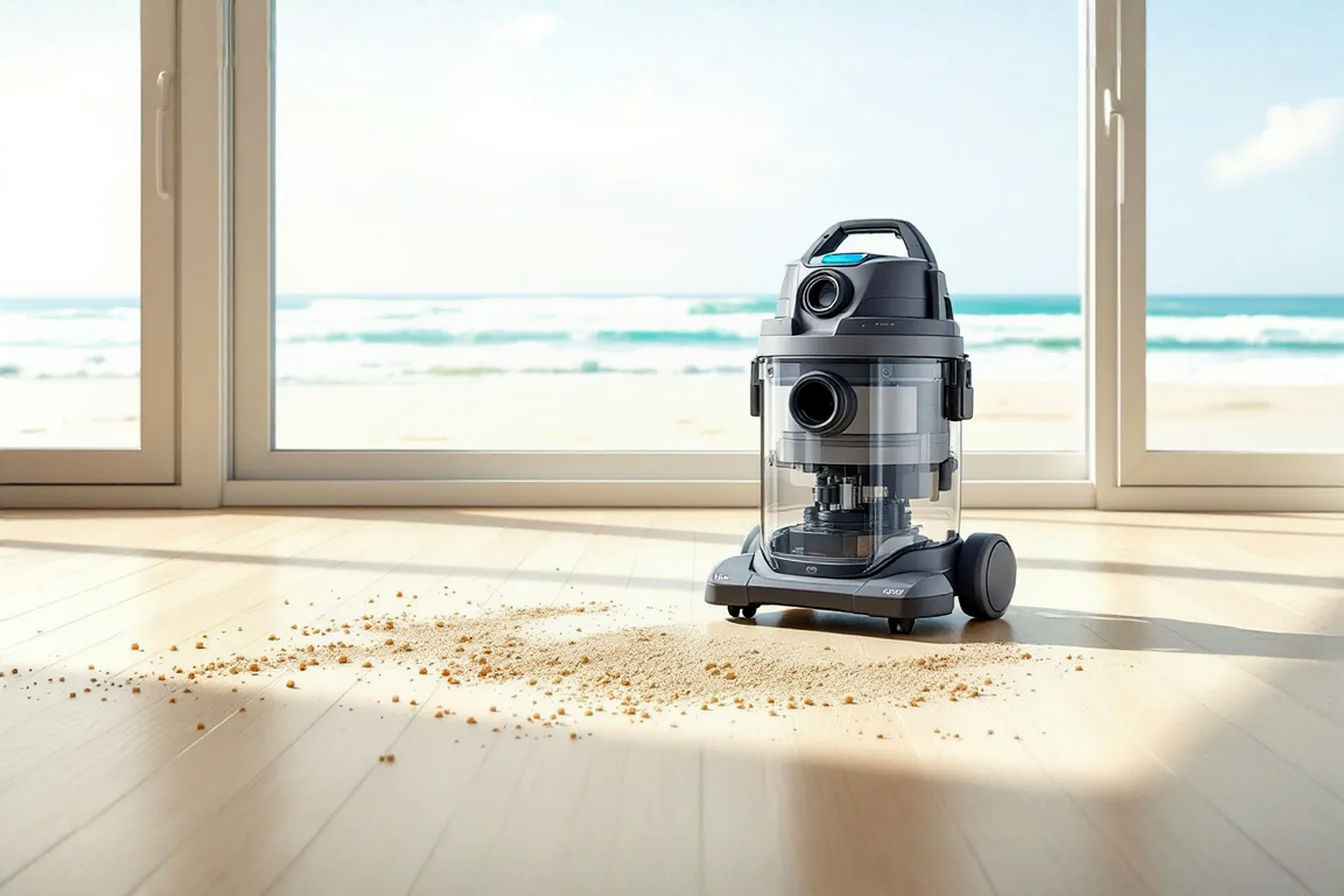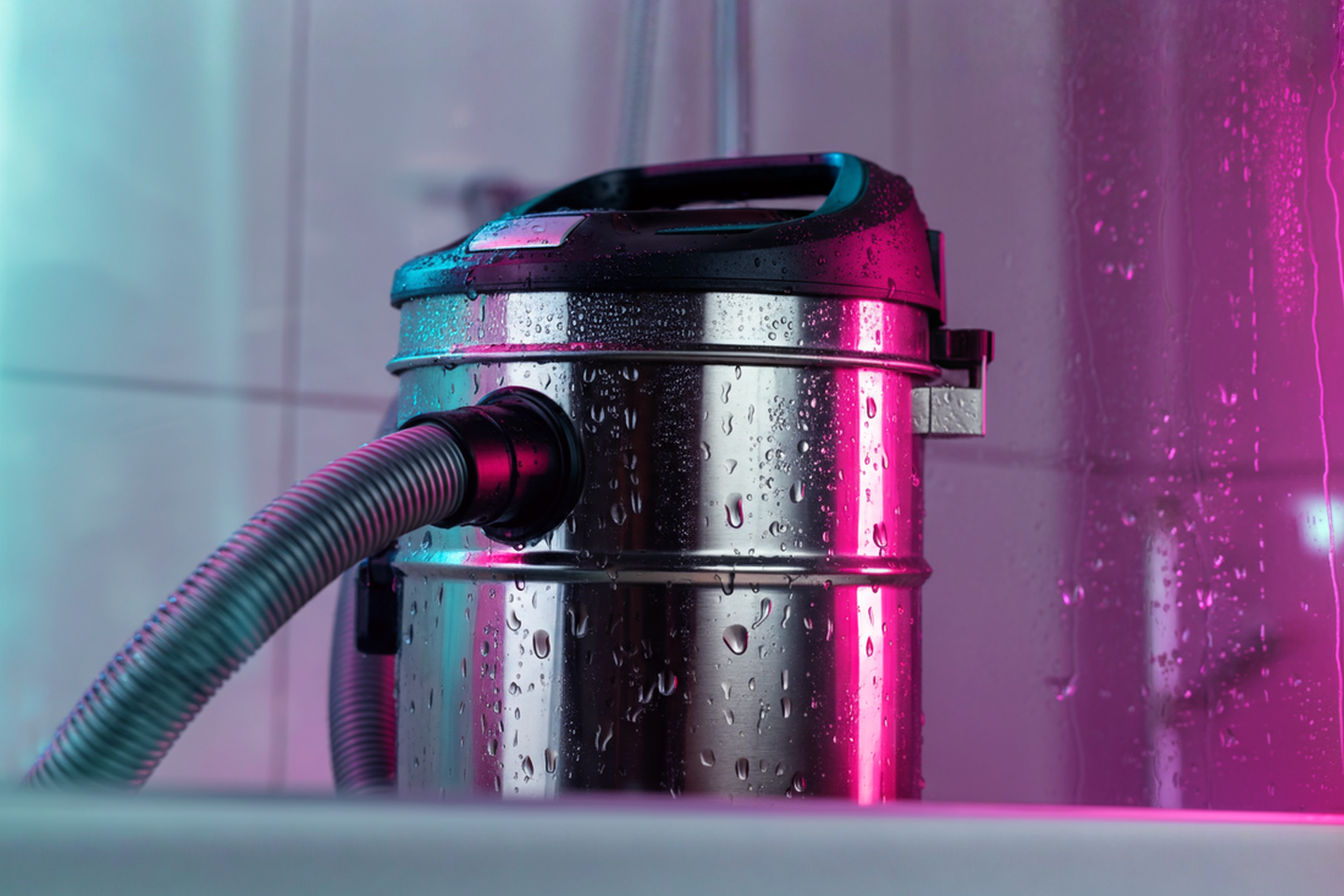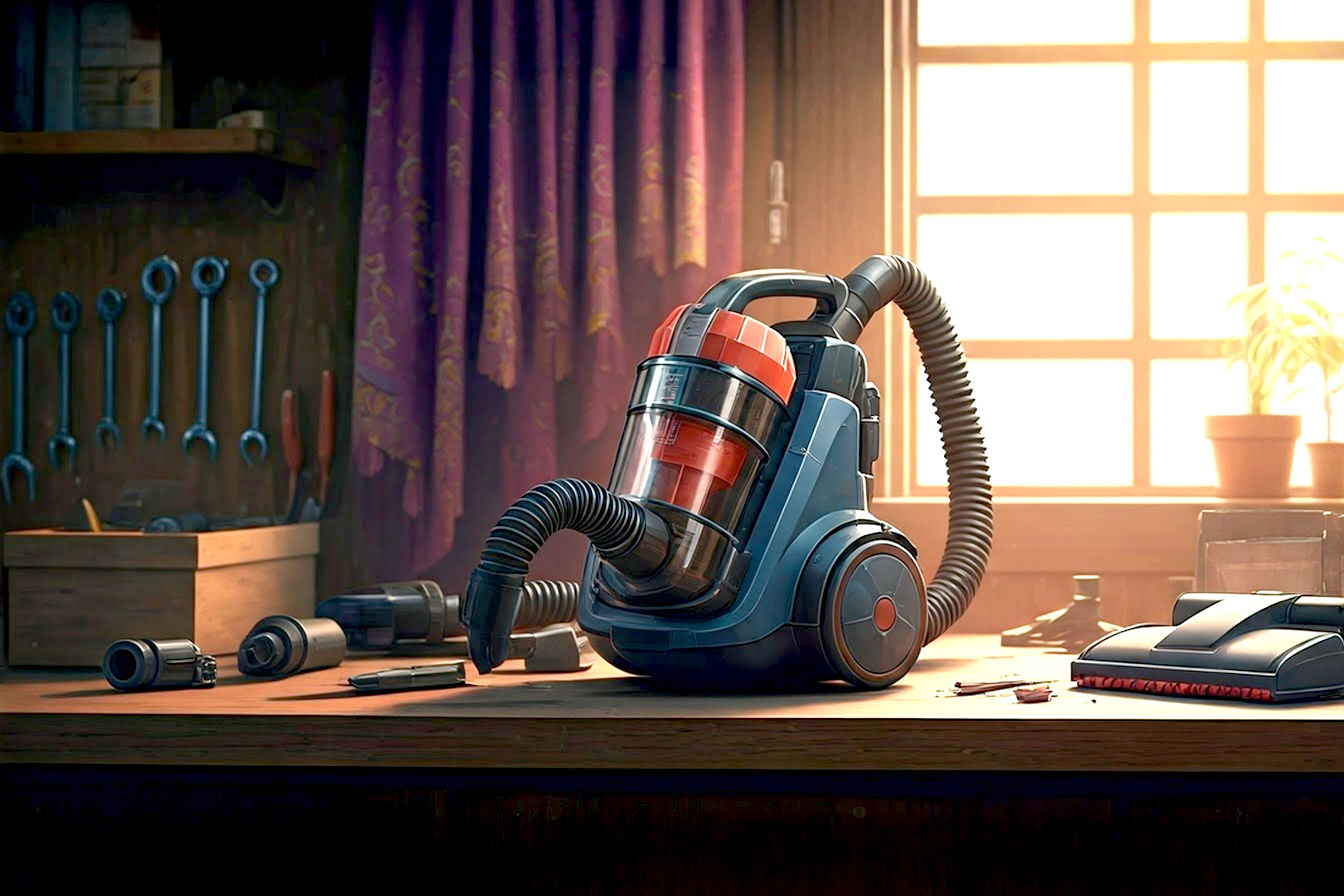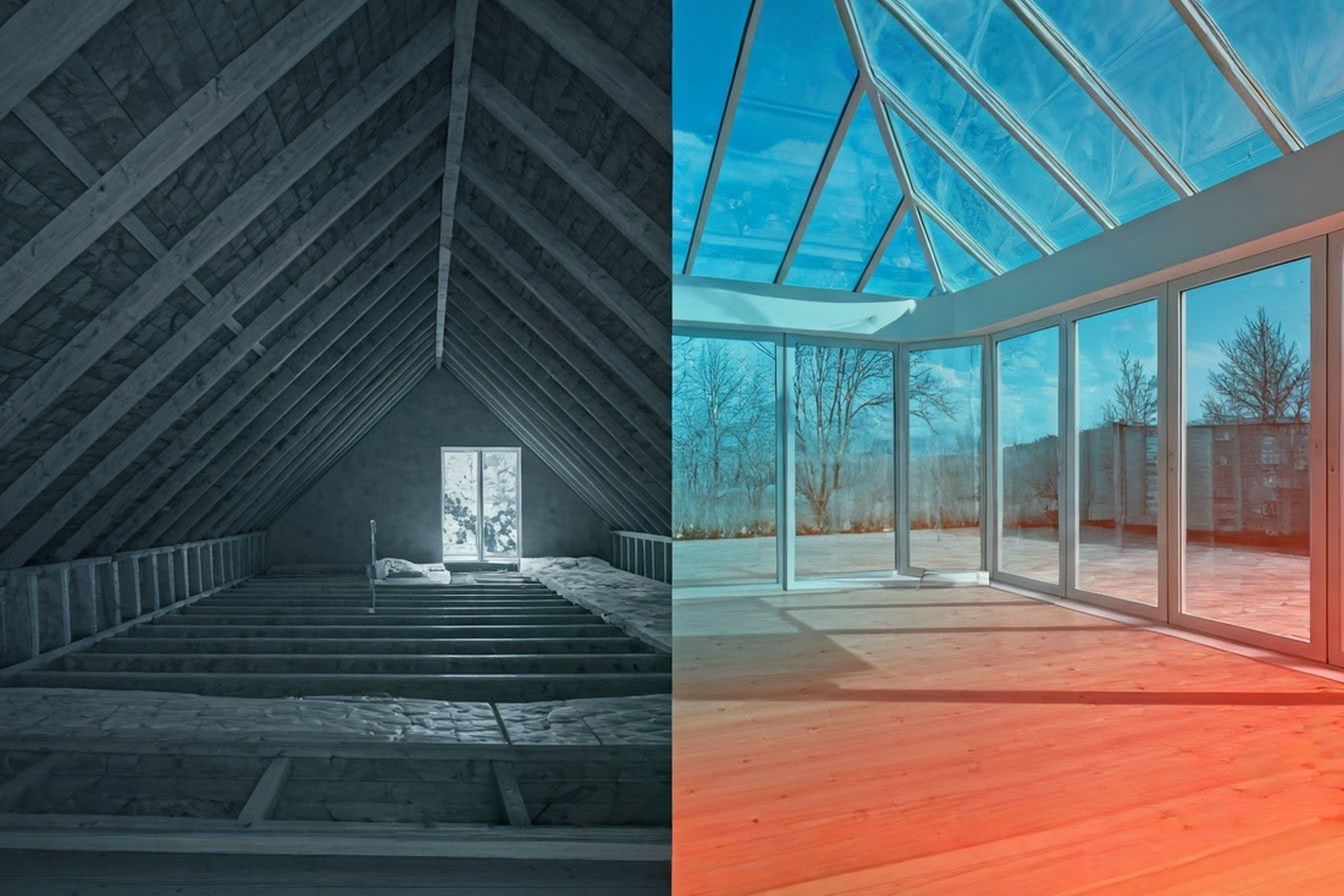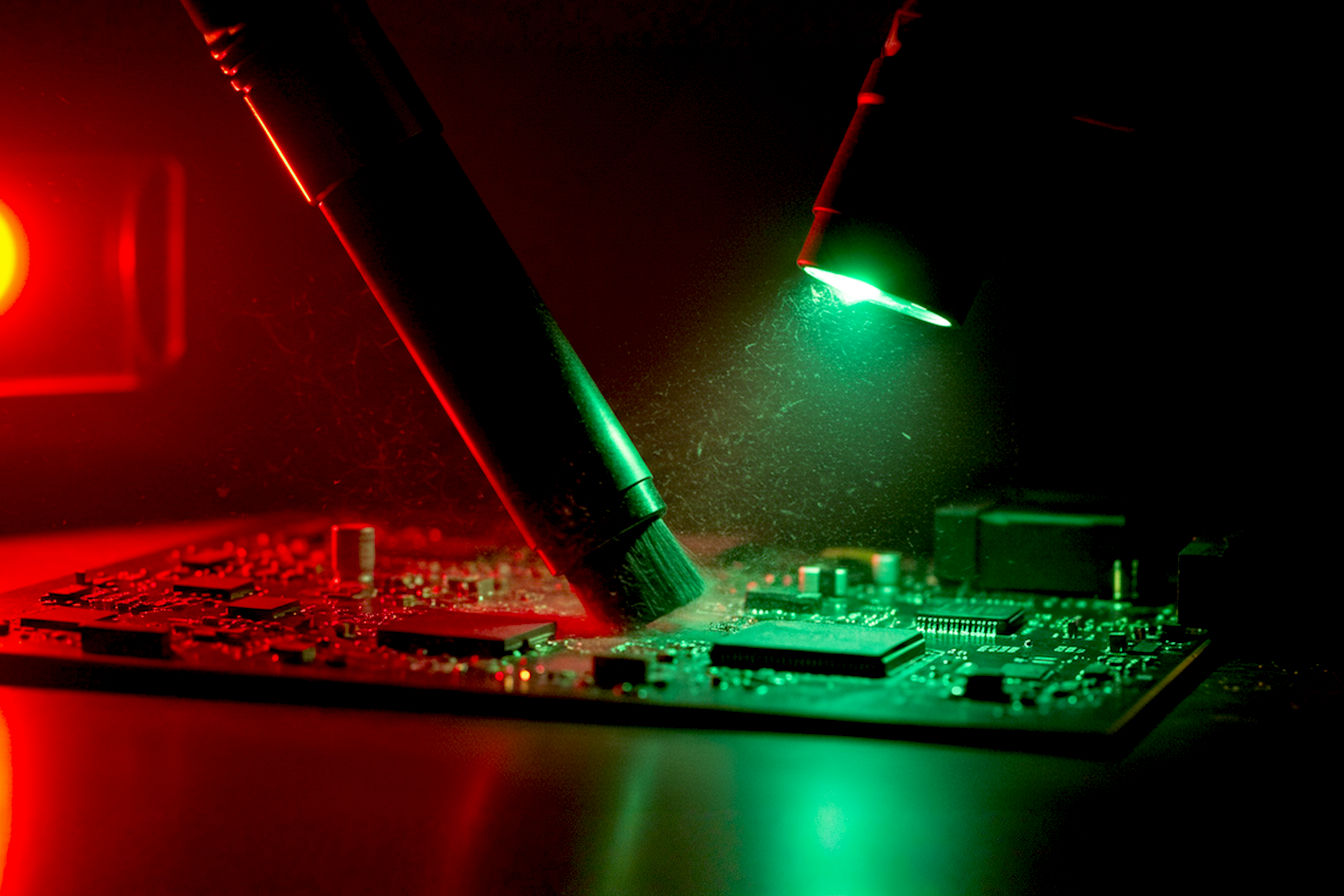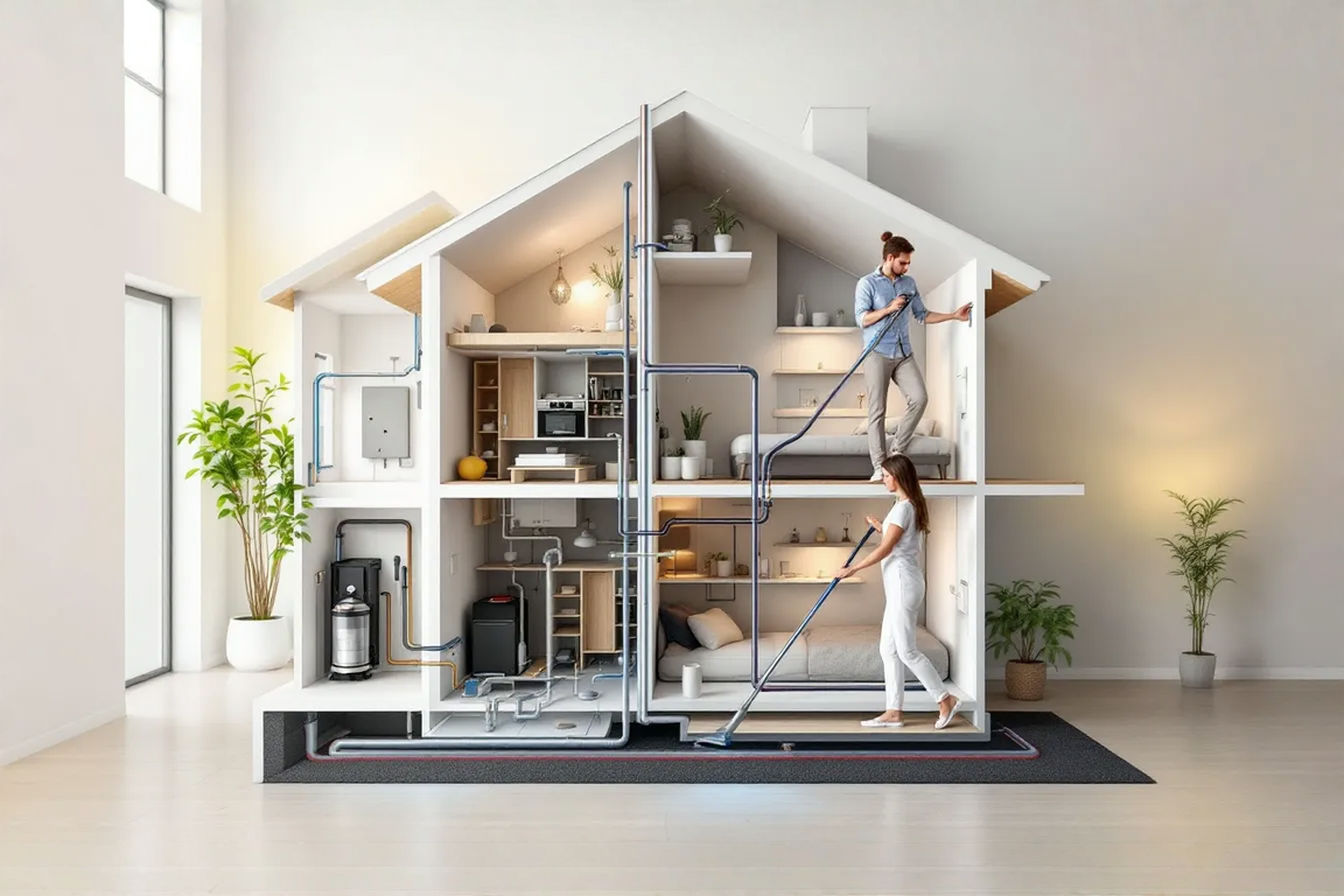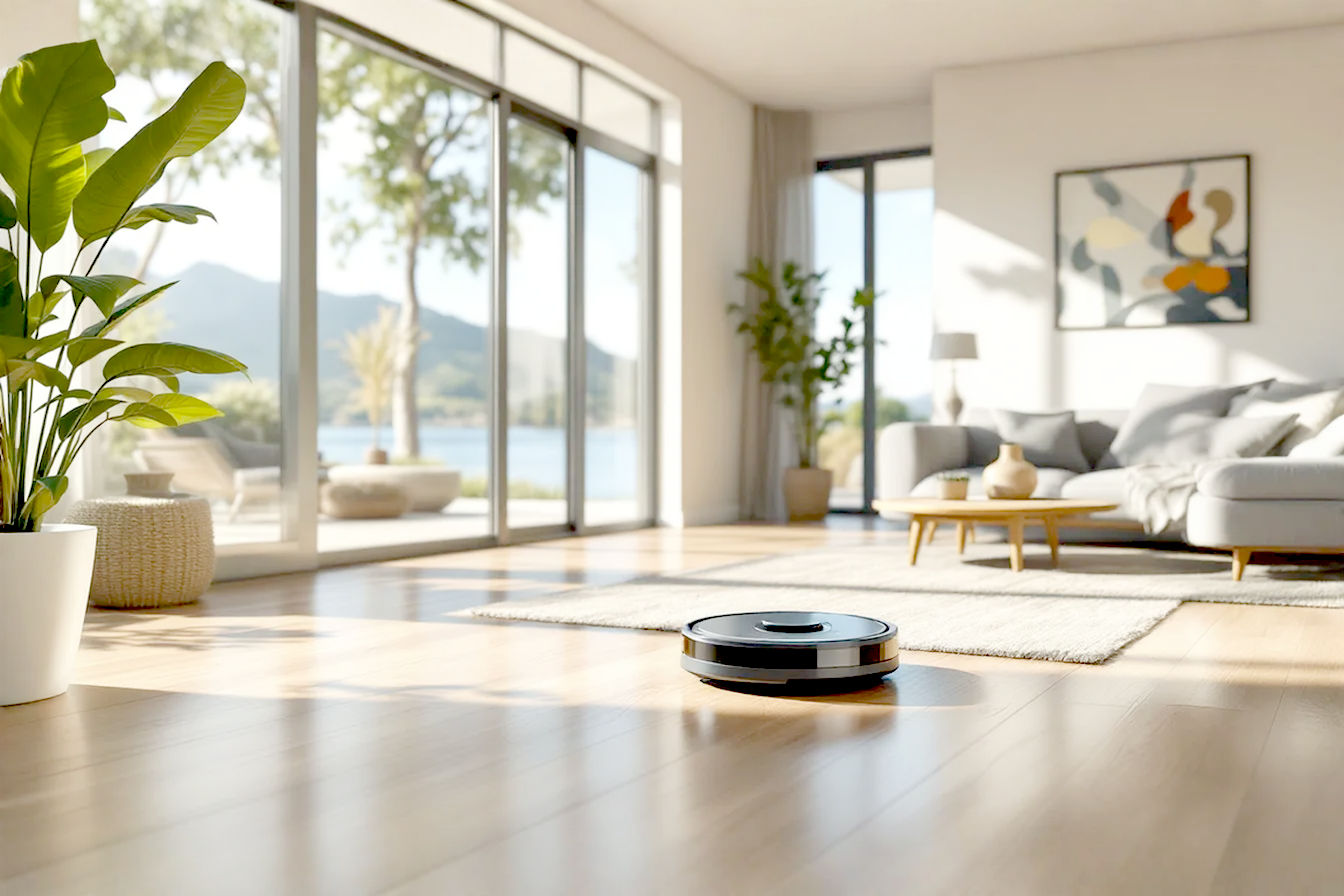Coastal Home Challenges: Salt Air and Sand-Resistant Vacuum Features
Living by the coast creates unique cleaning challenges. Discover how salt air and sand affect vacuum cleaners, and which specialized features can help your equipment last 3x longer in beach environments.
This post may contain affiliate links. If you make a purchase through these links, we may earn a commission at no additional cost to you.
Living in a coastal home offers breathtaking views and a relaxing atmosphere, but it also presents unique cleaning challenges that many homeowners don’t anticipate. The combination of salt air, fine sand, and elevated humidity levels creates a particularly harsh environment for household appliances—especially vacuum cleaners. These elements can significantly reduce the lifespan of standard cleaning equipment and compromise cleaning effectiveness when you need it most.
For coastal residents, understanding how these environmental factors affect vacuum cleaners isn’t just about maintaining a clean home—it’s about protecting a significant investment. Standard vacuum models often fail prematurely when regularly exposed to coastal conditions, leading to frustrating breakdowns and unnecessary replacement costs.
This comprehensive guide explores the specific challenges coastal environments pose to vacuum cleaners and details the essential features that can help your cleaning equipment withstand these demanding conditions. Whether you’re a new beach homeowner or looking to upgrade your existing cleaning arsenal, we’ll cover everything from corrosion-resistant materials to specialized filtration systems designed specifically for coastal living.
Understanding Coastal Home Cleaning Challenges
The Triple Threat: Salt, Sand, and Humidity
Coastal homes face a unique combination of environmental factors that create a perfect storm for vacuum cleaner damage. Understanding these challenges is the first step toward selecting equipment that can withstand them.
Salt Air Corrosion
Salt air contains microscopic salt particles that settle on nearly every surface in coastal homes. These particles are highly corrosive, particularly to metal components. When salt deposits combine with moisture, they create an electrolyte solution that accelerates the oxidation process in metals—essentially speeding up rust formation by up to 10 times faster than in non-coastal environments.
Inside a vacuum cleaner, this corrosion can attack critical components like:
- Motor bearings and armatures
- Electrical connections and circuits
- Metal attachment tools and extension wands
- Internal screws, springs, and mounting hardware
Even internal components you can’t see are vulnerable, as salt-laden air gets pulled through the vacuum during operation, depositing corrosive particles throughout the internal workings.
Sand Ingress and Abrasion
Sand presents a different but equally damaging challenge. Beach sand consists of tiny, hard particles of quartz and other minerals that are naturally abrasive. These particles find their way into coastal homes regardless of how careful residents might be, embedded in carpets, tracked across hard floors, and settling in furniture.
When vacuumed, sand causes several problems:
- It acts like sandpaper against moving parts, causing premature wear
- Particles can clog filters much faster than normal household dust
- Fine sand can bypass standard filtration and reach the motor
- The abrasive nature can damage brushrolls and fan blades
- Accumulated sand adds weight and strain to the motor
Even small amounts of sand can cause significant damage over time, as the continuous abrasion gradually wears away components designed for standard household dust.
Humidity Impact
Coastal areas typically experience higher humidity levels than inland regions, with relative humidity often exceeding 70% year-round. This persistent moisture creates additional problems for vacuum systems:
- Encourages mold and mildew growth in dust collection systems
- Can cause electrical short circuits when condensation forms on circuit boards
- Accelerates corrosion when combined with salt particles
- Causes filters to clog more quickly as dust becomes damp
- May compromise suction efficiency when airflow passages collect moisture
The combination of these three factors—salt, sand, and humidity—creates a uniquely challenging environment that standard vacuum cleaners simply aren’t designed to handle long-term.
The Hidden Cost of Inadequate Equipment
Using standard vacuum cleaners in coastal environments often leads to a significantly shortened lifespan and diminished performance over time. This translates directly to increased costs and frustration for homeowners.
Shortened Vacuum Lifespan
Research shows that standard vacuum cleaners used in coastal environments typically last only 1-3 years compared to the 5-8 year average lifespan inland. This dramatic reduction comes from the cumulative damage of coastal elements:
| Component | Normal Lifespan | Coastal Lifespan | Primary Cause of Failure |
|---|---|---|---|
| Motor | 5-8 years | 1-3 years | Salt corrosion on windings |
| Filters | 6-12 months | 1-3 months | Sand clogging, mold from humidity |
| Electrical switches | 5+ years | 2-3 years | Corrosion on contacts |
| Brushrolls | 2-3 years | 6-12 months | Sand abrasion wear |
| Plastic casings | 8+ years | 3-5 years | UV damage, salt crystallization |
This accelerated deterioration means coastal homeowners often find themselves replacing vacuum cleaners two to three times more frequently than inland residents.
Performance Degradation Timeline
Even before complete failure, coastal vacuums experience a predictable decline in performance:
- 1-3 months: Noticeably reduced suction power as filters clog with fine sand
- 3-6 months: Increased operating noise as sand affects bearings and moving parts
- 6-12 months: Visible corrosion on external metal parts, especially screws and attachments
- 12-18 months: Intermittent electrical issues, especially after humid days
- 18-24 months: Significant power loss, overheating, and potential motor failure
This gradual deterioration means you’ll likely experience progressively worse cleaning results long before the vacuum completely fails.
Cost Comparison: Standard vs. Marine-Grade Equipment
While specialized coastal vacuum cleaners typically cost 20-40% more upfront than standard models, the long-term economics strongly favor the investment:
- Standard vacuum in coastal setting: $150-300 initial cost × 3 replacements over 8 years = $450-900 total
- Marine-grade vacuum: $300-500 initial cost + potential filter replacements = $300-600 total over same period
Additionally, the hidden costs extend beyond just replacement expenses:
- Time spent researching and purchasing replacement models
- Cleaning inefficiency during performance degradation periods
- Potential damage to flooring from sand not properly removed
- Environmental impact of disposing of failed units
These figures demonstrate why investing in appropriate equipment for coastal environments ultimately proves more economical despite the higher initial purchase price.
Essential Vacuum Features for Coastal Homes
Corrosion-Resistant Materials and Components
The first line of defense against coastal elements is selecting vacuum cleaners constructed with corrosion-resistant materials specifically designed to withstand salt air exposure.
Marine-Grade Metals and Plastics
Premium coastal-friendly vacuums utilize specialized materials:
- 316-grade stainless steel: Contains higher levels of nickel and molybdenum than standard stainless steel, making it significantly more resistant to salt corrosion. Used in critical components like axles, bearings, and attachment mechanisms.
- Anodized aluminum: Aluminum components treated with an electrochemical process that creates a durable, corrosion-resistant oxide layer. This treatment provides protection while maintaining lightweight properties.
- UV-stabilized ABS plastics: Standard plastics degrade with sun exposure (common in bright coastal homes). UV-stabilized polymers contain additional compounds that prevent brittleness and cracking from sun exposure and salt crystallization.
- Marine-grade polymers: Advanced composite materials designed specifically for saltwater environments, often derived from boat-building technology, offering exceptional durability against salt, sand, and humidity.
The difference becomes apparent after 6-12 months of use, when standard components begin showing visible corrosion while marine-grade materials maintain their integrity.
Sealed Motor Systems
The motor represents both the most expensive and most vulnerable component of a vacuum cleaner in coastal environments. Marine-grade vacuums feature specialized motor protection:
- Fully encapsulated motor housing: Prevents salt air and moisture from reaching the motor windings and electrical components.
- Double-sealed bearings: Utilize specialized rubber seals and marine-grade lubricants that don’t break down when exposed to salt moisture.
- Isolated electrical compartments: Separate the motor’s electrical components from the airflow path, minimizing exposure to salt-laden air passing through the vacuum.
- Thermal protection systems: Advanced sensors that detect overheating (common when filters clog with sand) and automatically shut down the motor before damage occurs.
These sealed systems typically add 30-50% to the motor’s cost but can extend its lifespan by 300-400% in coastal environments.
Protective Coatings and Treatments
Beyond base materials, specialized treatments provide additional protection:
- Conformal coating: A thin protective film applied to printed circuit boards that repels moisture and prevents salt corrosion on electrical connections.
- Anti-corrosion sprays: Factory-applied treatments on internal metal components that create a microscopic protective barrier against salt air.
- Sacrificial anodes: Some premium models include small zinc components designed to corrode first, protecting more critical components—a technology borrowed from marine equipment.
- Hydrophobic surface treatments: Applied to external surfaces to repel moisture and make cleaning salt residue easier during maintenance.
When selecting a vacuum for coastal use, these protective features should be explicitly mentioned in product specifications, as they’re not typically found in standard models.
Advanced Filtration Systems
Sand and salt particles present unique filtration challenges that require specialized systems beyond what standard vacuums offer.
HEPA vs. Standard Filtration for Sand Particles
Sand particles vary in size, with the finest particles measuring just 63 microns—small enough to bypass many standard filters. This is where advanced filtration becomes essential:
- HEPA filtration: High-Efficiency Particulate Air filters capture 99.97% of particles as small as 0.3 microns. This capability is crucial for trapping the finest sand particles that would otherwise reach the motor.
- Pre-motor vs. post-motor filtration: Coastal-optimized vacuums feature both pre-motor filters (protecting the motor from incoming particles) and post-motor HEPA filters (preventing recirculation of fine dust and salt particles).
- Filter construction materials: Coastal-specific filters often use materials like Gore-Tex that resist clogging from damp salt particles while maintaining airflow efficiency.
- Filter frame sealing: Premium coastal models feature rubber gaskets around filter frames to prevent fine particles from bypassing the filtration system entirely.
The difference in performance is significant—standard filters typically show 15-30% efficiency loss after just 2-3 uses in sandy environments, while marine-grade filtration maintains 90%+ efficiency for months.
Multi-Stage Filtration Benefits
Coastal vacuum models typically employ a series of filters, each targeting specific challenges:
- First-stage cyclonic separation: Creates centrifugal force to separate larger sand particles before they reach any filters, extending filter life dramatically.
- Second-stage mesh pre-filters: Capture medium-sized particles while allowing airflow to remain strong.
- Third-stage pleated filters: Trap fine sand and salt particles in a high-surface-area design that resists clogging.
- Final-stage HEPA filtration: Captures microscopic particles including fine salt crystals.
This cascading approach ensures no single filter becomes overwhelmed, maintaining suction power while protecting internal components.
Self-Cleaning Filter Technologies
The most advanced coastal vacuums incorporate innovative self-maintaining filter systems:
- Reverse-pulse cleaning: Periodically sends bursts of air backward through filters to dislodge accumulated sand and dust.
- Vibrating filter frameworks: Use micro-vibrations to prevent particles from embedding deeply in filter materials.
- Hydrophobic filter coatings: Prevent moisture from binding with dust and creating mud-like buildups that are difficult to remove.
- Filter-cleaning indicators: Alert users when maintenance is required, preventing damage from operating with clogged filters.
These self-maintenance features significantly reduce the frequency of manual filter cleaning—a particular benefit in coastal environments where filters require attention 3-4 times more frequently than in standard households.
Motor Protection Technologies
The motor represents both the heart of any vacuum and its most vulnerable component in coastal settings. Advanced protection systems are essential for longevity.
Bypass Motor Systems Explained
Standard vacuum motors pull air directly through their cooling systems, exposing internal components to whatever is in that airflow—including salt and fine sand. Bypass motor systems use a fundamentally different design:
- Separate air channels: One channel for cleaning suction and a completely separate channel for motor cooling.
- Independent cooling fans: Pull clean air for cooling rather than using the same airflow that contains dust and debris.
- Protected electronics: Circuit boards and electrical connections positioned in the clean airflow path, away from contaminated air.
This design approach costs more to manufacture but prevents salt and sand from directly contacting the most sensitive components, often extending motor life by 200-300% in coastal environments.
Cooling Systems for Humidity Management
Coastal vacuum motors must manage higher ambient humidity levels that can lead to condensation inside the motor housing. Advanced cooling approaches include:
- Thermal dissipation channels: Specially designed pathways that direct heat away from sensitive components while preventing moisture buildup.
- Condensation prevention systems: Maintain motor temperature above the dew point to prevent moisture formation during operation and cool-down.
- Moisture-wicking materials: Strategically placed around electrical components to absorb any condensation before it can cause damage.
- Ventilation design: Optimized airflow patterns that minimize humidity trapping while maximizing cooling efficiency.
Effective humidity management prevents the formation of corrosive moisture inside the motor housing—a leading cause of electrical failures in coastal environments.
Voltage Protection for Power Fluctuations
Coastal areas often experience power fluctuations during storms and high winds, creating additional stress on vacuum electrical systems. Premium models include:
- Surge protection circuitry: Guards against power spikes that can damage electronic components.
- Voltage stabilization: Maintains consistent power to the motor despite input fluctuations.
- Soft-start technology: Gradually increases power to full operating levels, reducing strain on components.
- Auto-shutdown protection: Detects unsafe power conditions and safely turns off the vacuum before damage occurs.
These electrical protection features are particularly valuable in remote coastal areas where power quality may be less consistent than in urban environments.
Vacuum Types Best Suited for Coastal Environments
Canister vs. Upright Models: Coastal Performance Comparison
Different vacuum designs offer distinct advantages and challenges when used in coastal homes. Understanding these differences helps match the right design to your specific coastal cleaning needs.
Structural Advantages for Sand Management
When comparing how different vacuum types handle sand:
- Canister vacuums: Typically offer better performance with sand due to their separated motor and collection system design. The longer hose pathway allows heavier sand particles to drop out before reaching critical components. The collection container is also usually larger, requiring less frequent emptying when dealing with high sand volume.
- Upright vacuums: Generally position the motor closer to the floor and intake, which can increase exposure to sand particles. However, newer upright designs with multi-cyclonic separation can partially mitigate this disadvantage.
- Stick vacuums: Often lack the filtration stages needed for effective sand management, making them less suitable as primary cleaners in coastal homes, though useful as supplementary tools.
The difference becomes particularly noticeable after cleaning entryways and high-traffic areas where sand accumulation is greatest. Canister models typically maintain suction performance 2-3 times longer between filter cleanings in these conditions.
Motor Placement Considerations
The physical location of the motor within the vacuum design significantly impacts its vulnerability to coastal elements:
- Canister vacuums: Position the motor farther from the floor intake, creating more distance between sand/salt intake and sensitive components. This design allows multiple filtration stages before air reaches the motor.
- Upright vacuums: Traditionally position motors closer to the floor intake, though premium coastal models now often elevate the motor position and add additional filtration stages.
- Backpack vacuums: Provide maximum elevation of motor components from floor-level debris, making them increasingly popular in commercial coastal cleaning applications.
Research shows that each additional inch of vertical separation between intake and motor can reduce sand exposure by approximately 15-20%, explaining why elevated motor designs often demonstrate superior longevity.
Maneuverability on Beach House Surfaces
Coastal homes often feature a variety of specialized flooring chosen to resist sand and moisture:
- Canister vacuums: Excel on mixed surfaces with their interchangeable heads and flexible hose systems. The separated design allows the heavy motor unit to remain stationary while only moving the lighter cleaning head.
- Upright vacuums: Offer one-piece convenience but may struggle on uneven tile transitions or with area rugs common in beach decor. The all-in-one design means moving the entire unit, including the motor, with each stroke.
- Robot vacuums: Navigate some beach house surfaces well but often struggle with high-pile area rugs and the fine sand that can interfere with sensors.
For homes with predominantly hard surfaces (common in coastal settings for easier sand removal), canister vacuums typically offer superior performance, while upright models may perform better on the wall-to-wall carpeting found in some coastal bedrooms.
Cordless Options for Beach Homes
Battery-powered vacuums offer convenience but face specific challenges in coastal environments that require careful consideration.
Battery Protection from Environmental Factors
Batteries and their electronic controls are particularly vulnerable to coastal conditions:
- Sealed battery compartments: Premium cordless models use rubber gaskets and specialized seals around battery connections to prevent salt air exposure.
- Conformal-coated circuit boards: Battery management systems require protection from humidity and salt air, achieved through specialized protective coatings.
- Temperature management systems: Advanced battery designs include sensors and cooling channels to prevent overheating—a common issue when filters clog with sand.
- Contact protection: Gold-plated or marine-grade battery contacts resist corrosion far better than standard metals.
Models specifically designed for harsh environments often advertise these features, while standard cordless vacuums typically lack this level of protection, leading to battery degradation 2-3 times faster in coastal settings.
Power Considerations for Sand Removal
Sand presents unique power demands that challenge battery systems:
- Motor power requirements: Removing embedded sand from carpets requires 30-40% more suction power than standard dust, rapidly depleting batteries.
- Runtime limitations: Most cordless models provide 20-40 minutes of operation—often insufficient for thoroughly cleaning a sand-affected home without recharging.
- Power modes: Look for models with specialized “sand” or “beach” modes that optimize power usage for different surface types.
- Battery technology differences: Lithium-ion provides more consistent power delivery for heavy sand removal than older NiMH batteries.
For coastal primary residences, cordless models typically work best as supplementary cleaning tools rather than primary vacuum systems, unless you invest in models with multiple batteries or extended runtime designs.
Storage Solutions to Minimize Exposure
Proper storage significantly impacts cordless vacuum longevity in coastal environments:
- Wall-mounted docking stations: Keep vacuums elevated away from floor-level sand and salt accumulation while providing controlled charging conditions.
- Climate considerations: Avoid charging and storing in areas with extreme temperature fluctuations or direct sun exposure, which can degrade battery performance.
- Humidity control: Store in areas with lower humidity when possible, or consider using desiccant packets near the storage location.
- Contact cleaning: Regularly clean charging contacts with appropriate electrical contact cleaner to prevent salt buildup and ensure proper charging.
With proper storage and maintenance, premium cordless vacuums can achieve a 3-4 year useful life in coastal homes, compared to 1-2 years for standard models casually stored.
Robot Vacuums: Coastal Viability Assessment
Autonomous cleaning sounds ideal for managing daily sand intrusion, but robot vacuums face unique challenges in coastal environments.
Sensor Challenges with Sand
Robot vacuums rely heavily on various sensors for navigation and operation, all of which can be affected by sand:
- Cliff sensors: Frequently false-trigger when encountering dark lines in flooring or fine sand accumulation, causing the robot to stop unnecessarily.
- Optical navigation systems: Can become confused by constantly changing floor appearances due to scattered sand, leading to inefficient cleaning patterns.
- Wheel sensors: Fine sand can infiltrate wheel mechanisms, causing inaccurate movement measurement and navigation errors.
- Brush rotation sensors: May detect increased resistance from sand and unnecessarily stop rotation, reducing cleaning effectiveness.
Premium coastal-optimized robot models incorporate sealed sensor designs and specialized calibration for beach environments, but still typically require more frequent maintenance than in non-coastal homes.
Maintenance Requirements in Salty Environments
Robot vacuums demand significantly more upkeep when dealing with coastal conditions:
- Filter maintenance: Requires cleaning or replacement every 3-5 uses in sandy environments compared to every.2-3 weeks in standard conditions.
- Brush maintenance: Sand rapidly wears down brush bristles and can jam rotating mechanisms, necessitating weekly inspection.
- Sensor cleaning: Optical sensors and navigation cameras need regular wiping to remove salt film buildup that affects performance.
- Wheel and roller maintenance: Moving parts require cleaning 3-4 times more frequently than in non-coastal settings.
This increased maintenance burden offsets some of the convenience benefits that make robot vacuums attractive, though newer models have begun addressing these challenges with self-cleaning systems.
Latest Beach-Friendly Innovations
Recent developments have made some robot vacuums more viable for coastal homes:
- Self-emptying bases: Automatically remove collected debris into larger containers, reducing exposure during manual emptying and increasing capacity for sand collection.
- Multi-surface rubber brushrolls: Replace traditional bristles with rubber fins that resist sand clogging and don’t trap pet hair—a common issue in beach homes where pets track in sand.
- Advanced object recognition: Helps robots distinguish between normal floor variations and actual sand piles requiring extra attention.
- Remote monitoring: Allows tracking of cleaning performance and receiving alerts when maintenance is needed due to sand accumulation.
- Water-resistant designs: Some newer models incorporate water-resistant electronics and sealed compartments specifically for coastal markets.
For coastal homeowners interested in robot vacuums, models specifically marketed for pet hair typically perform better with sand as well, due to their enhanced anti-clogging features and stronger suction systems.
Maintenance Strategies for Coastal Vacuum Cleaners
Specialized Cleaning Routines
Proper maintenance dramatically extends vacuum life in coastal environments and requires specific protocols beyond standard care.
Post-Use Maintenance Checklist
Implementing a quick maintenance routine after each use prevents cumulative damage:
- Empty collection containers immediately: Sand and salt should never be left in the vacuum after use, as humidity can cause them to harden and become more difficult to remove.
- Tap filters outdoors: Gently tapping filters against a solid surface outdoors removes loose sand before it can embed deeper in filter material.
- Inspect brush rolls: Remove hair and string after each use, as these trap sand particles against moving parts, accelerating wear.
- Wipe external surfaces: Use a slightly dampened microfiber cloth to remove salt residue from exterior surfaces before it can crystallize.
- Check and clear hose pathways: Ensure no sand accumulation exists in hose connectors and pathway transitions.
This 3-5 minute routine can extend a vacuum’s effective lifespan by 40-60% in coastal environments by preventing the compounding damage that occurs when salt and sand remain in the system.
Deep Cleaning Frequency Guidelines
More thorough maintenance should follow a coastal-specific schedule:
| Component | Standard Home Schedule | Coastal Home Schedule | Procedure |
|---|---|---|---|
| Filters | Every 3 months | Every 2-4 weeks | Rinse with fresh water, allow to fully dry for 24+ hours |
| Brush roll | Every 6 months | Monthly | Complete disassembly, bearing inspection, thorough cleaning |
| Hoses & pathways | Annually | Every 3 months | Check for sand accumulation in bends and connections |
| Motor housing | Rarely | Every 6 months | Remove outer housing, clean cooling vents, check for salt buildup |
| Electrical contacts | Never | Every 3 months | Clean with electrical contact cleaner, check for corrosion |
Following this accelerated maintenance schedule addresses coastal challenges before they cause permanent damage or performance reduction.
Detecting Early Signs of Salt Damage
Early intervention prevents catastrophic failure. Watch for these warning signs:
- Unusual noise during operation: Often the first indication of bearing corrosion or sand in moving parts.
- White powder residue: Salt crystallization on components indicates active corrosion processes.
- Reduced suction with clean filters: Suggests internal airflow restrictions from sand buildup in less accessible areas.
- Intermittent power issues: May indicate electrical contact corrosion affecting power delivery.
- Overheating: Often results from salt and sand restricting proper airflow through cooling channels.
When these symptoms appear, implementing immediate deep cleaning can often reverse the damage before it becomes permanent. If symptoms persist after maintenance, professional servicing should be considered.
Component-Specific Protection Measures
Different vacuum components require specialized care in coastal environments to maintain optimal performance.
Filter Maintenance and Replacement Schedules
Filters face the greatest impact from coastal conditions and require particular attention:
- HEPA filters: In coastal homes, these typically require replacement every 3-4 months rather than the annual replacement recommended for inland homes. Attempting to extend usage beyond this point often results in reduced filtration efficiency and motor strain.
- Pre-motor filters: Should be rinsed weekly in coastal settings, using room-temperature fresh water (never hot) and allowed to dry completely before reinstallation to prevent mold growth.
- Foam filters: Particularly vulnerable to salt damage and should be replaced rather than cleaned when they begin to show discoloration or brittleness.
- Filter seals and gaskets: Inspect monthly for signs of deterioration, as these are often made from materials that degrade when exposed to salt.
Maintaining a regular replacement schedule prevents the cascade of problems that occur when filters fail, including motor damage and reduced cleaning effectiveness.
Motor Housing Protection Tips
The motor requires special attention as the most expensive component to replace:
- Ventilation pathways: Use compressed air (at low pressure) monthly to blow out salt and sand from motor cooling vents without removing covers.
- Housing seals: Apply a thin layer of silicone lubricant to rubber seals quarterly to prevent cracking from salt exposure.
- Sound insulation: Check sound-dampening material around motors, as this often absorbs moisture and salt, holding it against metal components.
- Thermal protection: Ensure thermal cutoff switches remain free of debris, as these prevent overheating when filters clog with sand.
Professional servicing annually allows thorough internal motor cleaning that can add years to a vacuum’s useful life in coastal settings.
Electrical Component Preservation
Electrical systems are particularly vulnerable to salt air corrosion:
- Cord care: Wipe power cords with a slightly damp cloth monthly to remove salt residue, paying special attention to the areas where cords enter the vacuum body.
- Switch protection: Apply electronic-safe lubricant to mechanical switches quarterly to prevent salt intrusion and maintain smooth operation.
- Circuit board protection: While not user-serviceable, keeping the vacuum in a climate-controlled environment when not in use helps prevent condensation on electronic components.
- Battery connection maintenance: For cordless models, clean battery contacts monthly using a cotton swab moistened with isopropyl alcohol.
These preventative measures address the leading causes of electrical failure in coastal vacuum cleaners before they progress to complete system failure.
Storage Solutions to Minimize Exposure
How and where you store your vacuum significantly impacts its longevity in coastal environments.
Climate-Controlled Storage Options
The ideal storage environment dramatically reduces environmental stress:
- Indoor storage: Always store vacuums inside the climate-controlled area of the home rather than in garages or outdoor storage areas where humidity and temperature fluctuations are greater.
- Elevation importance: Use wall-mounted hooks or brackets to keep vacuums off the floor, where sand concentration is highest.
- Closet selection: Choose storage closets on interior walls rather than exterior walls, as the latter experience more temperature fluctuation and potential condensation.
- Avoid bathroom proximity: The high humidity from bathrooms can accelerate corrosion in nearby stored equipment.
Research indicates that vacuums stored in climate-controlled environments last 30-50% longer in coastal settings than those kept in garages or outdoor storage.
Dehumidification Approaches
Controlling humidity around stored vacuums provides significant protection:
- Dedicated dehumidifiers: Small closet dehumidifiers in vacuum storage areas maintain optimal humidity levels below 50%.
- Desiccant packets: Silica gel packets placed near stored vacuums absorb excess moisture and can be rejuvenated in ovens for reuse.
- Moisture-absorbing products: Commercial products containing calcium chloride can be placed in storage areas to reduce ambient humidity.
- Regular air circulation: Periodically running stored vacuums for 2-3 minutes monthly prevents moisture accumulation in motors and internal components.
These approaches directly counter one of the primary catalysts for salt damage—humidity that activates the corrosive properties of salt deposits.
Protective Covers and Cases
Physical barriers provide additional protection against environmental exposure:
- Breathable covers: Use covers made from breathable materials that prevent dust and salt air infiltration while allowing moisture to escape, preventing condensation.
- Vacuum-specific bags: Some premium models offer custom storage bags with moisture-resistant linings specifically designed for their dimensions.
- Accessory organization: Store attachments and hoses in sealed containers rather than leaving them exposed, where they collect salt residue.
- DIY solutions: Simple approaches like covering vacuums with cotton sheets protect against dust while allowing airflow to prevent humidity buildup.
For seasonal residents, proper storage during extended absences becomes even more critical, as vacuums left unattended for months can experience significant deterioration without proper protection.
Expert Recommendations and Product Selection
Investment Considerations for Coastal Residents
Purchasing a vacuum for coastal environments requires balancing immediate costs against long-term value and performance.
Price vs. Longevity Analysis
The economics of coastal vacuum selection follow a predictable pattern:
- Entry-level vacuums ($100-200): Typically last only 6-18 months in coastal environments, with rapidly declining performance. The false economy of these models becomes apparent quickly as sand damages motors and filters clog repeatedly.
- Mid-range vacuums ($200-400): Without specific coastal features, these typically last 1-3 years but require frequent part replacements, particularly filters and brushrolls.
- Premium standard vacuums ($400-600): Even high-quality conventional vacuums will underperform in coastal settings, averaging 2-4 years of service with declining effectiveness.
- Coastal-specific models ($350-800): Purpose-built vacuums with marine-grade components typically deliver 5-8 years of consistent performance, representing significantly better value despite higher initial costs.
The data clearly shows that investing in purpose-built equipment typically yields a 30-40% lower total cost of ownership over a 10-year period compared to repeatedly replacing standard vacuums.
Warranty Considerations for Beach Environments
Warranty terms become particularly important for coastal purchases:
- Standard warranties: Many manufacturers explicitly exclude “environmental damage” or “excessive dust conditions” in warranty terms, creating potential coverage gaps for coastal users.
- Commercial-grade warranties: Often provide better coverage for harsh environments, as they’re designed for high-demand settings.
- Coastal-specific coverage: Some manufacturers now offer specialized warranty programs for registered coastal users, acknowledging the unique challenges.
- Supplemental coverage: Third-party extended warranties sometimes provide better protection than manufacturer warranties for coastal applications, though terms should be carefully reviewed.
Before purchase, request written clarification on whether saltwater proximity or sand damage affects warranty coverage. This single step can prevent disappointing claim denials later.
Cost-Effective Upgrades for Existing Vacuums
For those not ready to invest in a new coastal-specific vacuum, strategic upgrades can extend the life of existing equipment:
- Aftermarket HEPA filters: Upgrading to higher-quality filters can substantially improve sand filtration and motor protection for $30-60.
- Motor protection kits: Some vacuum service centers offer specialized sealing kits that better isolate motors from salty air for $50-100.
- Brushroll replacements: Upgraded brushrolls with sand-specific designs can improve cleaning performance and reduce mechanism wear for $25-45.
- Protective sprays: Electronics-safe corrosion inhibitors applied to electrical contacts and metal components can slow deterioration for under $20.
These targeted investments can extend vacuum life by 30-50% in coastal environments while improving performance, providing a bridge until full replacement becomes necessary.
Performance Features Worth the Premium
Not all coastal-focused features deliver equal value. Understanding which upgrades matter most helps optimize your investment.
Critical vs. Optional Coastal Features
Some features provide essential protection, while others offer diminishing returns:
Critical Features (Highest ROI):
- Sealed system design: Prevents fine dust and salt from bypassing filters
- Multi-stage filtration: Captures particles at various sizes before reaching the motor
- Corrosion-resistant materials: Particularly for fasteners and electrical contacts
- Washable pre-motor filters: Allow frequent cleaning without replacement costs
- Elevated motor position: Increases distance from floor-level sand intake
Valuable But Secondary Features:
- HEPA filtration: Important for allergies but secondary to system sealing for longevity
- Commercial-grade components: Often overbuilt for residential use, even in coastal settings
- Specialized floor tools: Can improve sand removal but don’t affect vacuum longevity
- Variable suction control: Helpful for delicate beach house decor but not essential
Minimal Impact Features:
- UV sterilization: Offers little practical benefit for sand and salt issues
- Fragrance diffusers: No impact on cleaning performance or longevity
- Smart connectivity: Rarely improves coastal-specific performance challenges
- Noise reduction features: Often create additional sealing challenges
Focusing investment on critical features while considering secondary ones based on specific needs provides the best value proposition for coastal residents.
Future-Proofing Your Purchase
Technological advancements continue to improve coastal vacuum performance. Forward-looking features to consider include:
- Modular construction: Allows replacement of individual components rather than entire systems when salt damage occurs.
- Washable sealed HEPA filters: Combine high filtration with coastal practicality, reducing replacement costs.
- Brushless DC motors: Offer superior longevity in harsh environments with fewer vulnerable components.
- Advanced materials science: Newer polymers and composites specifically engineered for salt resistance.
- Self-cleaning mechanisms: Automatically clear sand from critical pathways without manual intervention.
While these features may add 15-25% to purchase price, they typically deliver 50-100% longer service life in challenging coastal environments.
Adaptability for Different Coastal Climates
Coastal environments vary significantly in their specific challenges:
- Tropical coastal areas: Higher humidity creates greater corrosion acceleration. Prioritize sealed electrical systems and moisture protection.
- Mediterranean-type coastlines: Extremely fine, dry sand that penetrates deeply. Emphasis should be on multi-stage filtration with fine particle capture.
- Northern coastal regions: Salt combined with winter conditions. Look for models with temperature-stable components and seals.
- Island environments: Often face extreme salt concentration. Require the highest grade of corrosion protection available.
Understanding your specific microclimate helps target features that address your primary environmental challenges rather than paying for unnecessary protections.
Top-Rated Models for Specific Coastal Challenges
Different vacuum types excel at addressing particular coastal cleaning challenges.
Best for Heavy Sand Environments
For homes with direct beach access and high sand infiltration:
- Canister vacuum designs generally outperform other types due to their longer filtration pathways and separated motor units. Look for models with:
- High-capacity dust containers
- Multiple cyclonic separation stages
- Specialized hard floor tools with stiff bristles
- Sand-specific attachments for upholstery
- Commercial-grade backpack models increasingly popular in beach rentals, providing:
- Maximum separation between intake and motor
- High-capacity collection systems
- Ergonomic design for frequent whole-house cleaning
- Powerful suction for embedded sand removal
The investment in these specialized systems ($400-700) quickly pays dividends through superior sand management and reduced clogging frequency.
Superior Performers in High-Humidity Regions
In areas with humidity consistently above 70%, focus on:
- Models with advanced airflow engineering that separate moisture from the air path
- Vacuums with sealed motor compartments using marine-grade seals
- Units featuring moisture-resistant electronic controls
- Systems with anti-mold treatments in dust collection components
Gulf Coast and tropical island residents particularly benefit from these moisture-management features, which prevent the humidity-activated corrosion that accounts for nearly 40% of vacuum failures in these regions.
All-Around Champions for Multiple Coastal Factors
For environments combining salt, sand, and humidity challenges, several models consistently earn top ratings from coastal residents:
- Commercial-grade sealed canister systems: Offering exceptional filtration, separated motors, and robust construction materials
- Marine-grade upright vacuums: Featuring elevated motors, multiple filtration stages, and specialized coastal warranties
- Premium cordless systems with replaceable batteries: Providing convenience without the corrosion vulnerability of cord connections
While specific model recommendations change as manufacturers update offerings, vacuums marketed to coastal rental property managers consistently offer the best combination of features for residential coastal use, even at premium prices.
Conclusion
Living in a coastal paradise shouldn’t require compromising on clean floors or constantly replacing failed vacuum cleaners. The unique combination of salt air, sand infiltration, and elevated humidity creates cleaning challenges that standard equipment simply wasn’t designed to handle.
By investing in vacuum cleaners with corrosion-resistant materials, advanced filtration systems, and sealed motor designs, coastal residents can achieve both superior cleaning results and significantly longer equipment lifespan. While these specialized features typically add 30-50% to the initial purchase price, they deliver 200-300% longer service life—representing substantial savings over time.
The most critical considerations for coastal vacuum selection include:
- Sealed system design that prevents fine particles from bypassing filtration
- Multi-stage filtration that captures particles of various sizes
- Corrosion-resistant materials for all metal components
- Motor protection technologies that isolate critical components from salt exposure
- Appropriate vacuum type for your specific coastal challenges
Equally important is establishing a consistent maintenance routine tailored to coastal conditions. Regular filter cleaning, proper storage in climate-controlled spaces, and preventative care of electrical components dramatically extend vacuum lifespan even in the harshest coastal environments.
By combining the right equipment selection with appropriate maintenance practices, coastal homeowners can effectively manage the challenging cleanup requirements of beach living while protecting their investment in quality cleaning equipment. The result is not just cleaner floors but also significant long-term savings and reduced environmental impact from premature equipment disposal.
Living by the coast presents unique challenges, but with the right tools and knowledge, keeping your coastal home pristine doesn’t have to be one of them.

